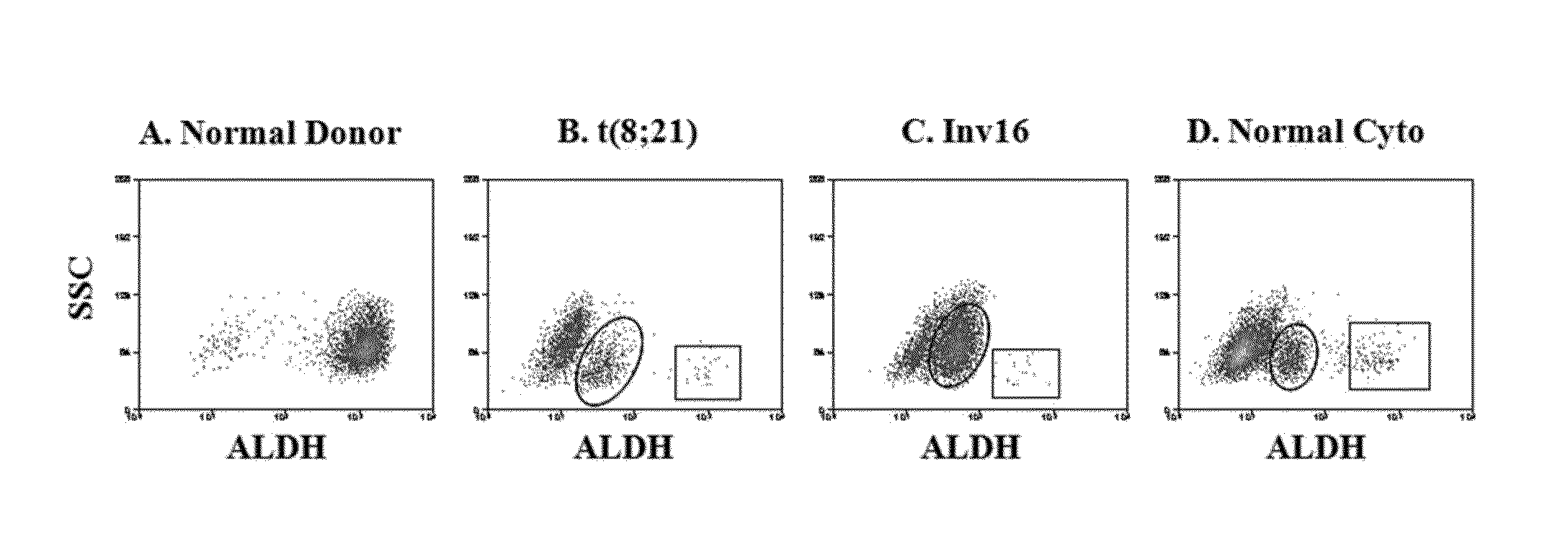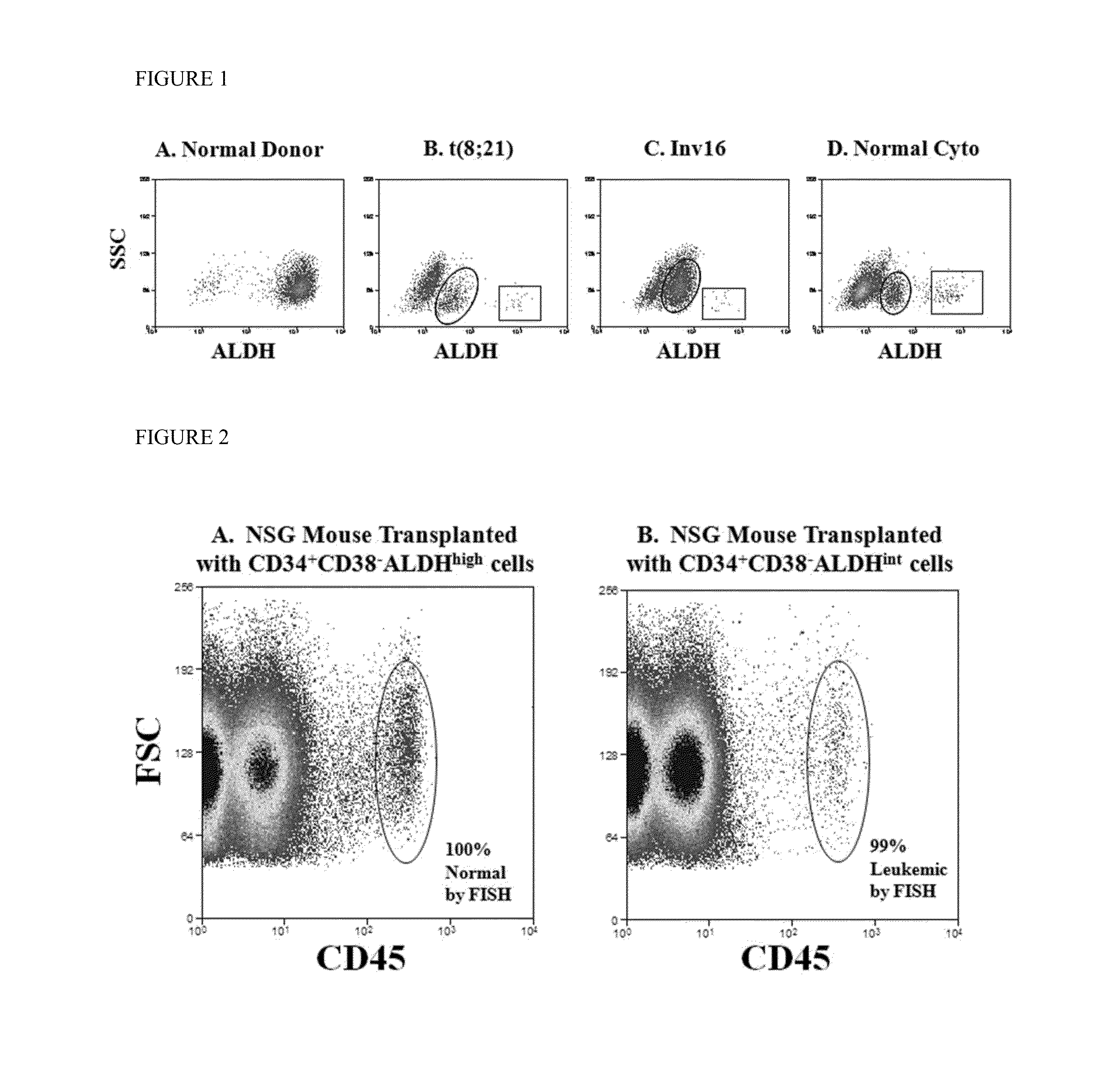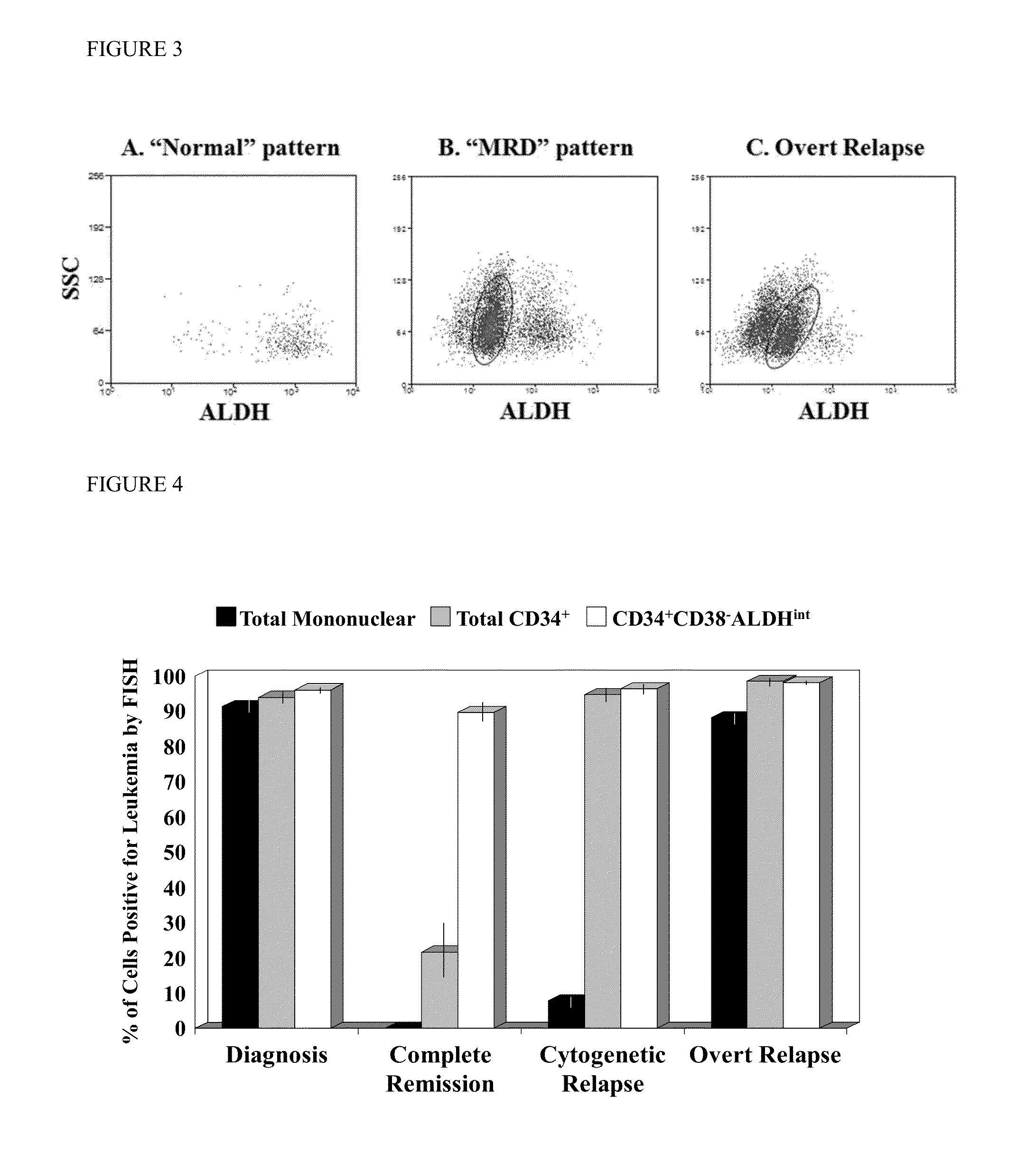Methods for identifying leukemia stem cells and distinguishing them from normal hematopietic stem cells in patients with acute myeloid leukemia: uses in diagnosis, treatment, and research
a technology for acute myeloid leukemia and stem cells, which is applied in the field of identifying leukemia stem cells and distinguishing them from normal hematopietic stem cells in patients with acute myeloid leukemia, can solve the problems of lscs that are not responsible for disease resistance or relapse, and the gold standard for identifying lscs has proved to be somewhat elusive, so as to increase the risk of relapse and increase the risk of aml
- Summary
- Abstract
- Description
- Claims
- Application Information
AI Technical Summary
Benefits of technology
Problems solved by technology
Method used
Image
Examples
example 1
[0045]ALDH activity distinguishes CD34+CD38− leukemic cells from their normal counterparts. Normal bone marrow CD34+CD38− cells consistently exhibited two, non-overlapping subpopulations by ALDH activity: one expressing low ALDH activity (CD34+CD38−ALDHlow) and another expressing high activity (CD34+CD38−ALDHhigh) (FIG. 1A). The normal marrow CD34+CD38−ALDHhigh cells comprised an average of 10% (range 9-12%) of the total CD34+ cells and 76% (range 61-85%) of the CD34+CD38− cells. As few as 1000 of these CD34+CD38−ALDHhigh cells generated engraftment when transplanted into NSG mice (data not shown).
[0046]Initial AML analyses focused on patients with newly-diagnosed CBF leukemias, as the FISH-detectable abnormalities allowed quantification of the percentage of leukemic cells in isolated populations. In contrast to the normals, the CD34+CD38− cells from all CBF AML patients exhibited three well-defined subpopulations by ALDH activity. In addition to the CD34+CD38−ALDHlow and CD34+CD38−...
example 2
[0050]Presence of the CD34+CD38−ALDHint population following treatment predicts relapse. Of the 20 AML patients analyzed at diagnosis, three had primary refractory disease, one died during induction chemotherapy, one did not receive full induction or any consolidation chemotherapy due to medical complications, and two others had CD34− leukemia. Of the 13 patients with CD34+ leukemia who achieved morphologic CR after induction chemotherapy, follow-up samples were available in nine. An additional seven AML patients who achieved CR, but in whom diagnostic samples were not available, were also followed: two starting after induction and five after consolidation therapy.
[0051]The CR samples exhibited two general patterns. Of the eight patients analyzed in first morphologic CR following recovery from induction and prior to consolidation chemotherapy, five patients (see table at FIG. 6) exhibited a “normal” pattern: a predominant CD34+CD38−ALDHhigh population and a smaller CD34+CD38− ALDHlo...
example 3
[0053]MRD after chemotherapy is enriched for leukemic CD34+CD38−ALDHint cells. Although the three patients in cytogenetic CR exhibiting the “MRD” pattern had no morphologic, karyotypic, or FISH evidence of disease in the unfractionated marrow cells, the leukemia-specific abnormality was still detectable in a minority (average 22%, range 8-36%) of the total CD34+ cells and in the vast majority (average 90%, range 85-95%) of the CD34+CD38−ALDHint cells (FIG. 4). This leukemic CD34+CD38−ALDHint population, which represented only 0.15% (range 0.04-0.25%) of the total mononuclear cells, comprised an average of 34% (range 9-51%) of the total leukemic burden in these cytogenetic CR patients with the “MRD” pattern. In contrast, this population constituted only 2% (range 0.3-7%, p+CD38−ALDHint population decreased by only 13-fold (p=0.4) (FIG. 5).
[0054]In the three patients with cytogenetic, but no morphologic evidence of disease (i.e., cytogenetic relapse), an average of 8% (range 4.5-9.5%)...
PUM
| Property | Measurement | Unit |
|---|---|---|
| disease resistance | aaaaa | aaaaa |
| fluorescence in | aaaaa | aaaaa |
| wavelengths | aaaaa | aaaaa |
Abstract
Description
Claims
Application Information
 Login to View More
Login to View More - R&D
- Intellectual Property
- Life Sciences
- Materials
- Tech Scout
- Unparalleled Data Quality
- Higher Quality Content
- 60% Fewer Hallucinations
Browse by: Latest US Patents, China's latest patents, Technical Efficacy Thesaurus, Application Domain, Technology Topic, Popular Technical Reports.
© 2025 PatSnap. All rights reserved.Legal|Privacy policy|Modern Slavery Act Transparency Statement|Sitemap|About US| Contact US: help@patsnap.com



